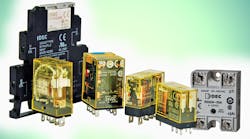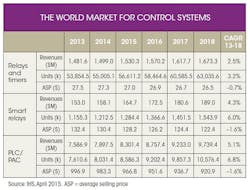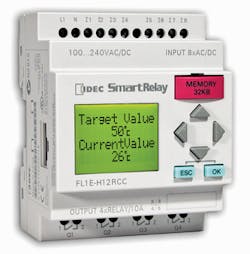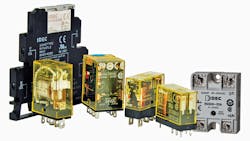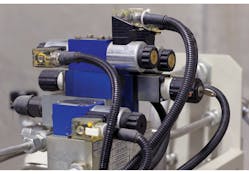This file type includes high resolution graphics and schematics when applicable.
According to the research firm IHS Inc., about 54 million relays and timers were purchased in 2013, a number projected to grow annually by 3.2% to reach 63 million by 2018. Relays account for the vast majority of products in this category.
IHS’s research further indicates that smart relays will experience a 6.0% compound annual growth rate (6.0%) through 2018, while logic controllers, specifically programmable logic controllers (PLCs) and programmable automation controllers (PACs), will maintain a 6.8% CAGR (see the table below). Logic controllers are replacing relays and timers to perform control-system logic in a wide range of applications. Yet, in spite of the rapid growth of smart relays, PLC, and PACs, demand for simple relays remains strong.
PLCs, PACs, and Smart Relays
PLCs are solid-state logic controllers that possess a very wide range of capabilities and features, and have become the mainstay of machine control since their introduction. Low-end PLCs, often called micro PLCs, rely on built-in inputs and outputs (I/Os), and have limited I/O expansion capability. Typically equipped with only one or two communication ports, they’re often used to control simple machines. High-end PLCs can accommodate thousands of I/Os, come with multiple communication ports, and can be applied in control large, complex machines.
A PAC is a high-end PLC that adds advanced functions such as the ability to perform multi-axis motion control. PLC and PAC use is on the rise because both automate machines and processes that were once manually controlled. They frequently replace older control systems built with relays and timers, and form the heart of most new machines and manufacturing plants.
Smart relays are low-end PLCs characterized by a limited number of inputs and outputs. Unlike a PLC or PAC, all of the I/Os are usually built into the smart-relay housing, with no local or remote I/O expansion capability. Smart relays generally have limited or no analog I/O, and are usually programmed with ladder logic or function-block programming languages. Smart-relay growth is driven mainly by the the need to replace older relay-/timer-based control systems in simple standalone applications.
Control systems based on relays and timers are difficult to configure versus those with smart relays and PLCs/PACs. Smart relays and PLCs/PACs are simply programmed in software to control a machine or process, while relays and timers must be connected by hardwiring to perform control logic. Even simple control applications require many relays and timers, and, consequently, lots of panel space. Relay/timer controls also lack flexibility, as modifications typically require rewiring and additional relays and timers.
The final nail in the coffin for relay-/timer-based control systems is the declining cost of smart relays. For a new control system, designers will most likely opt for a much more capable and flexible smart relay, which can be purchased for as little as $150, rather than one based on relays and timers. In fact, a control system with 10 relays and timers—a significantly more limited option than smart-relay controls—costs about the same.
However, even with advances, relays are still needed in the industry as they often help logic controllers perform their functions.
What’s the Simple Relay’s Role?
Relays are widely used in conjunction with smart relays, PLCs, and PACs to isolate inputs, increase output switching capability, and other purposes. These devices can be either an electromechanical relay (EMR) or solid-state relay (SSR).
EMRs are often utilized for fail-safe operation with logic controllers. An electromechanical relay can be set to fail to a known state upon losing power—a feature not easily implemented with logic controllers. EMRs are considered more “fail-safe” because they usually fail in the normally open or off state, whereas a logic controller’s output can fail in the normally closed or on state.
Many relays have solid-state instead of electromechanical compoenents. SSRs are generally preferred over EMRs in applications that require frequent switching. SSRs tend to be more reliable than their electromechanical counterparts because they don’t have moving parts, justifying their higher cost (about double that of a comparable EMR).
This file type includes high resolution graphics and schematics when applicable.
Relays and Electrical Currents
This file type includes high resolution graphics and schematics when applicable.
Some field device inputs generate large amounts of electrical noise and thus must be isolated from logic-controller inputs on smart relays, PLCs, and PACs. In these cases, an interface relay is often employed, with input from the field device wired to the relay’s input, and the output contact from the relay wired to the logic-controller input.
In some instances, a logic controller will not have enough power to drive a particular field device, such as a solenoid, motor contactor, direct-current servo motor, or other loads requiring at least 100 mA for activation. An interface relay can be used in these situations with the logic-controller output connected to the relay input, and the relay output driving the load and protecting the logic-controller output from the field device. This protection is important because load variations can cause outputs to fail. If an interface relay fails, it can be replaced rather easily, particularly if it’s a “plug-in” type. However, if a logic-controller output fails, the entire device must often be replaced, a time-consuming and expensive proposition.
Relays can also be used to simply and inexpensively multiply a single discrete output. One logic-controller output is wired to the input of a relay, and several output contacts from that single relay drive multiple loads.
Protecting Logic Controllers from Pneumatics
Relays are applied extensively as interface devices in pneumatic applications. Used in assembly, pneumatic devices often have 100 or more of these devices on a single line. Some of these devices incorporate solenoids and others are driven by external solenoid banks. In both cases, an interface relay is often used with a logic-controller output to switch the pneumatic device solenoid on and off.
Pneumatic devices driven by ac solenoids have a 7:1 to 10:1 inrush current ratio. Inrush current is the initial input switch-on surge current required to turn on the device. The inrush ratio is high because the amount of power needed for solenoid activation is much higher than the amount required to hold it in an “on”state. This high solenoid inrush current creates a potential risk of damage to the logic-controller output.
Using a relay as an interface device, with the logic-controller output wired to the relay input and the relay output driving the solenoid, will inexpensively protect the logic controller while providing the power needed to activate the solenoid. Typically, a 6- or 14-mm wide relay can perform this task.
Because these relays are only a fraction of the size of older 22- to 36-mm designs, many 6- and 14-mm-wide relays can be installed on a DIN rail, which is the typical relay installation method for applications that demand a high number of relays. DIN rails are standard mounting brackets for installing relays and other items in control panels.
Relay Advances
Increased demand for smart relays and PLCs/PACs, and the subsequent rise in relay use, continues to push forward advances in relay technology. For example, relays are now available as DIN-rail-mount modules with multiple inputs and outputs. Newer 6- and 14-mm DIN-rail-mount relays are quickly replacing traditional 22- to 36-mm versions, simply because slimmer relays take up less space and provide more output channels. For instance, a two-pole, 14-mm relay can replace a two-pole, 22-mm relay, saving 6 mm of space per relay. Although this doesn’t seem to be much room, it can become significant when using many smaller relays. In the future, eight or more relays may be packaged together to reduce required space, cost, and wiring.
The latest 6- and 14-mm relays come sealed, and can be supplied with UL and IEC ratings for use in hazardous areas. Typically, such areas are found in chemical plants and refineries, but can very well expand to printing, marine, paint booths, and certain food and beverage processing operations. These sealed relays can be used with logic controllers—which aren’t sealed and thus can’t be applied in most hazardous areas—to gather inputs from, and provide switching to, field devices in hazardous areas.
Needless to say, relays are here to stay as they provide the most cost-effective way to isolate and protect logic-controller inputs and outputs. And their reach extends well beyond that, in all types of fail-safe, hazardous-area, and other specialized applications.
A Brief History of the Relay in Industrial Control |
|
Early relays, invented around 1835, were an integral part of telegraph systems. As recently as the 1980s, many small-scale machines and processes were controlled by a combination of relays, timers, and analog instruments. Not only was it possible to build a control system in this manner, but cost-effective in many cases as well, since PLCs were still quite expensive in the 1970s to the 1980s. They ranged in price from $3,500 to $7,000, particularly in applications requiring analog I/O and control. Operator interfaces for these control panels were provided by lights and panel meters to indicate status; inputs were via pushbuttons for on-off control and thumbwheel potentiometers for entering analog values. But while control systems based on relays, timers, and analog instruments were often cheaper than PLC-based systems in terms of component costs, they were fiendishly complex to design, test, modify, and troubleshoot. Any changes required the addition and/or deletion of components along with corresponding hardwiring. If new operator interface components were needed, holes had to be cut in panels. If anything went wrong, troubleshooting a panel composed of hundreds of relays and timers turned into a nightmare. A solution was needed for even small-scale control systems. The answer, albeit indirectly, was the PC. The soaring popularity of the PC after its introduction in the early 1980s plummeted the cost of many electronic components. This, in turn, drove down the cost of PLCs and other electronic controllers, because they used similar types of components. It also cut the price of graphics monitors, which became cost-effective replacements for lights, panel meters, and other operator input devices. This marked the beginning of the end for relays as the engines of discrete logic control. When PLCs were priced in the thousands of dollars, relay-based control systems still made economic sense for small and simple machines. However, when PLC prices dropped into the hundreds of dollars, and PLCs could be programmed using a PC instead of an expensive programming terminal, it hastened the descent of relay-based control systems into oblivion. However, while relay-based control systems became obsolete, a new door opened for relays. From its introduction in the 1960s until today, the PLC and its close cousins, the smart relay and PAC, have enjoyed strong growth. And because relays are often needed in conjunction with PLCs, demand for these simple yet versatile components grew right along with the PLC’s meteoric rise. With PLC unit demand jumping about 7% per year, and relays following in their wake with annual unit growth of about 3%, their popularity will likely continue for the foreseeable future. |
This file type includes high resolution graphics and schematics when applicable.
